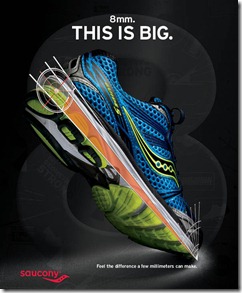 As anyone who has been reading this blog for awhile knows, I’ve long been a fan of Saucony shoes. The Kinvara has been my go-to long run shoe for the past year, and was on my feet for each of my last two marathons. The zero drop Hattori is also a nice little shoe, and with a little reworking of the upper to create a more secure fit and eliminate blistering problems, it could rank as one of my personal favorites.
As anyone who has been reading this blog for awhile knows, I’ve long been a fan of Saucony shoes. The Kinvara has been my go-to long run shoe for the past year, and was on my feet for each of my last two marathons. The zero drop Hattori is also a nice little shoe, and with a little reworking of the upper to create a more secure fit and eliminate blistering problems, it could rank as one of my personal favorites.
Beyond my regular personal use of some of their shoes, perhaps what I like most about Saucony’s approach to footwear is that they are diversifying their shoe line across the board, and they are making variation in heel-forefoot drop a major thrust of their design process. In addition to a full suite of traditional 12mm drop models, they have filled out the 4mm drop category with the Kinvara, Mirage, Cortana, and Grid Type A4. They also have the aforementioned zero drop Hattori. However, a big gap exists between the 4mm and 12mm models – that’s about to change.
To what I’m sure will be the delight of some, and horror of others, Saucony is moving three of it’s flagship shoes – the Guide 5, Triumph 9 and Hurricane 14 – from a 12mm heel-to-forefoot drop to an 8mm heel-to-forefoot drop. In doing so, Saucony fills a gap for people who want to make a slow progression to shoes with a lower heel=forefoot offset. While one can argue about whether a step-down approach or a barefoot-up approach is best, the reality is that there are a lot of runners who will never consider running barefoot. For these individuals, the step-down approach can make good sense as it gives the calf and Achilles time to adapt to a lower heel. The following video explains Saucony’s thoughts on this, and it has some really great slow-motion footage of a heel vs. a midfoot strike:
Saucony contacted me last week and offered to send me a pair of either the Guide 5 or Triumph 9 to test and review here on Runblogger. I initially hesitated as I rarely run in anything greater than about 4mm drop these days, but I have a personal history with one of these shoes that led me to agree to agree to a trial. The Saucony Guide was actually the last “traditional” shoe that I wore before making my minimalist transition (which started with the Nike Free 3.0 back in Spring 2009), and it’s the shoe that I now put on whenever I want to feel how strange it is to stand in a shoe with a 12mm heel raise. Now that I’m essentially zero drop most of the day and generally no more than 4mm drop when I run, it’s kind of strange to imagine that I actually was ever able to run in a shoe with such a slanted sole (funny how things change as you adapt to more minimal footwear!). Anyway, I’m curious to see how the new Guide compares as it will help me to provide recommendations to those looking for step-down shoes.
I don’t have the shoes yet, but they will be sent out soon. In addition to sending me a pair, Saucony offered to provide a pair to one of my readers. I’ve never run any kind of contest before here on the blog, but I guess there’s a first for everything!
So, here’s the deal. Answer the questions below and submit to enter. On Monday I will randomly select a winner from the entrants and contact the individual via email to put them in touch with Saucony to claim the prize (either the Guide 5 or Triumph 9) and arrange shipping. I hope this form works – I’ve never tried this before!
Update 10/17/2011: The shoe giveaway has been closed and a winner has been selected – congrats to Jacob Shipley!
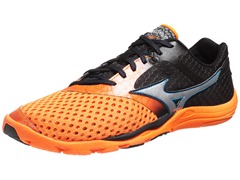

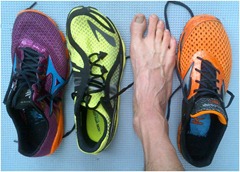
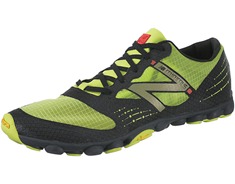
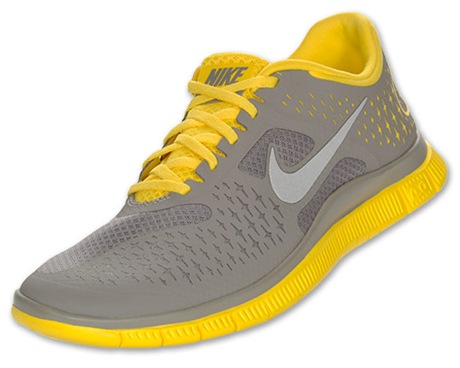














It is encouraging to see more shoe manufacturers becoming involved in lowering heel heights. Perhaps children who are very young now will never have to relearn how to properly stride.
That video is fantastic. It is really nice to see major companies doing this. So many more options than there were years ago, or even a year ago for that matter.
We expressed shock when saucony raised the heel from the guide 2 to the guide 3. I don’t know that saucony ever released stack height measurements that were different between the 2 models, but it was obvious when you tried each on.
Our rep and his bosses were surprised that we cared about that and were unsure at first whether to care about it…much less do anything about it. I think it’s a testimony of a brand that cares about and responds to customer feedback (not to mention logic and some preliminary science) that they would make such a 180 on design philosophy. This is why saucony is #1 at our store. We are VERY excited about the 8mm shoes!
The video is kind of funny “We discovered bla bla bla..” , “We reduced the heel from 12mm to 8mm to help runners land more mid-foot, yada yada”…
This is like McDonald saying we discovered that too much food makes u gain weight, and we reduced our meal from 1/4 pounder to 1/8 pounder.. So you gain less weight…
The barefoot & minimalist community have said & knows this truth for a long time, they also know that 0 is far better than 8mm, and 8mm (though I use the NB 101, which has ~8mm) are getting even significant to me as well, and disturb my mid-foot landing efforts.
The shoes companies are responding to the minimalist trend, they have their marketing hears open for sure. However, seems to me that their efforts are not as honest & professional as we would want it to be.
They sell/sold us for years shoes that are eventually delivering UN-healthy running form. Out of the blue the magically discovered the “truth” and reduce the heal. I can only guess that next year’s discovery is going to be that 4mm is better than 8mm ! (You gotta leave something for next year, right ?)
Its ok to do marketing & its great that they are going in the right direction, but I think their messaging is ignorant & patronizing the minimalist & educated community of runners who already understand the benefits of zero drop & midfoot landing contribution to better running form & less injury of its runners.
Despite this, I do like Sacuony shoes, and think that Kinivira (amazingly light weight & well constructed) & Peregrine are great transition shoes, while not minimalist do encourage better running form.
In fairness, Saucony put out the Kinvara at 4mm almost before any of the other companies jumped on the bandwagon. They have developed their 4mm offerings and also put out a true zero drop shoe before moving these shoes to 8mm. As far as big shoe companies, they have been far more proactive than most.
Don’t get me wrong. I am not against this direction.
I just think their marketing can be more modest. They didn’t discover it.
Is this the first shoe company that’s actually making changes to their core existing products? That’s pretty impressive.
Yes, I think so. They initially did it to the Grid Type A4, now are moving some of the core line down.
Pete.. just a honest question without pouring cold water on Saucony in any way… given all midsloe materials have a density variance of approximately 10% in the manufacturing process.. ie a midsole with a Shore A of 55 degrees can be anywhere from 50 to 60 from shoe to shoe.. how much difference do you think a 4 mm differential will make in real terms once compression is allowed for? This is one of many issues I struggle with.. guess it gets back to sourcing more homogeneous materials.
the other relevant issue is that midsoles are not manufactured to scale for foot size.. so an 8mm drop in a size 12 is substantially less than an 8mm drop in a size 7.. would it not make sense to agitate for scaling of size?
Manufacturing issues are an issue for sure, but in my experience measuring shoes with C-calipers most hit pretty close to the advertised offset. With time, midsole compression will likely vary due to the reasons you suggest as well as things like the weight of the runner, and probably foot strike type. But, if you assume heterogeneity is a problem in all shoes, it should fall out as variation about a mean. So a 12mm offset may range a bit about that number, and a 8mm will do the same.
Slope is an excellent point. If you maintain the same height differential between heel and forefoot, slope will be more severe in a smaller shoe. Drop would be the same, but the slope would change. This is my problem with a lot of kid’s shoes – they are essentially mini versions of adult shoes and have a crazy downward slope from heel to toe. Scaling by size would be ideal, but I suspect that would increase manufacturing costs, would it not? That might make the logical choice unlikely to happen. In a perfect world, we’d all have custom shoes! The nice thing about zero drop shoes is you don’t have to worry about this – slope will always bee the same.
Pete
I will add the in my opinion 4mm may seem like a small change, but for me a 4mm lift in the heel never causes me calf soreness, whereas if I de-acclimate running in zero drop shoe can still take a toll on my calves.
Pete, a lot of talking about magic 4 mm here. Should we expect your review of MT110?
Soon I hope!
Marketing hype/fluff aside, this is really great news. The progress is too slow for some, but things are definitely heading in the right direction. I have put a lot of miles on the Kinvaras this year, and am very happy to have had that option. We kind of take them for granted now, but just a year or two ago there really wasn’t an equivalent option out there. Props to Saucony!
Yeah, we’re spoiled these days. Remember the dark ages of 2009 when there were just Nike Free, Vibrams, and racing flats….
I think it is a step in the right direction for the majority that aren’t obsessive like us. The mainstream probably make up 80-90% of purchases so reducing the heel counter by 4mm should assist transition then yes next year perhaps they can bring it down to 4mm again. Better slow and steady. As Pete said they have 4mm and 0mm drop shoes for those that want them.
I do agree about the marketing side of things and their revelation that less heel is better! I wonder if they ever did a video similar to this for when they increased the heel. Would be interesting to see their reasoning for that!
I wore cheap water shoes (from walmart and sports authority) before there were sturdier options… I still see them as legitimate options.
Hey Pete:
Just out of morbid curiosity, besides the Hoka One One Mafate, what is the most extreme heel-toe drop you have seen in a mainstream running shoe (not that the Mafate is mainstream, but you know what I mean)? My old Brooks Adrenalines have a huge heel, but it can’t be the biggest one on the market.
I think the Hokas are actually low drop, but the midsole is really thick. Big drop would be a shoe like the Nike Shox I’d guess. Personally, biggest drop shoe I won are Saucony Bullet retro shoes. Bought them thinking they would be really minimal for casual wear, but they’re like 18-19mm drop with the insole in, but have zero cushioning in the forefoot – it’s all in the heel. I plan to take a hacksaw to them at some point…
As
you noted, it makes sense for the shoe industry to offer products
between the traditional 12mm heel-to-toe drop shoe and minimalist 0 –
4mm drop shoes. In fact, reflecting on your prior post and the
dissapointingly large percentage of VFF runners who continue their
over-striding heel striking form, it occurs that this may in part be the
result of the absence of such interim shoes to help the runner
gradually adapt their running form. Nevertheless, it seems clear to me
that even with such shoes that over-striding heel striking runners who
are truly interested in making a successful migration towards a lower
drop shoe will need to be more conscious of increasing their cadence,
incorporating a slight forward lean from the ankles, and ideally
incorporating some very helpful proprioceptive cues as outlined within
Matt Fitzgerald’s article taken from his helpful Brain Training for
Runners book (link to active.com….
In my successful migration from my heel to my mid-foot I found helpful
listening to gradually faster paced music (I’m a big fan of Steve
Boyette’s PodRunner music) as by increasing gradually by two beats per
minute per week my feet automatically struck the ground at the exact
tempo of the music.
Pete do you plan on reviewing the brooks pure line?
Yes – I have the Connect but they are way too narrow for my taste. Need to return them for the Flow, so may take some time.
Did you try running in them? For me they felt too narrow when I tried them on, but I liked them when running.
link to runnersworld.com…
– rovatti
No, my foot was hanging over both sides if the sole – way too narrow for me
Pete,
Could your post your foot dimensions with your next shoe review? I’ve enjoyed all your shoe reviews, but I can’t rely on them anymore to find shoes that fit me. Width seems so subjective without any dimensions. For example, you’ve written good things about the New Balance 101 and the Brooks Mach 12, but I’ve had to extensively modify both shoes’ toeboxes to fit my wide forefoot. Then, I just purchased the Pure Connect, and find I can tolerate them better than either model. Is it just a stretchy upper? Subjective feelings of comfort?
The most useful review will have the reviewer’s foot dimensions (not in “size” but in mm: foot length, longest digit, heel width, width at metatarsals, and maybe a foot photo to show whether the metatarsal parabola is broad or narrow) and the reviewed’ shoes dimensions and “size.” Thanks for the consistently great work.
I’ll give it a shot. Funny on the Connect as I find them way too narrow for me, I would compare them to the Mach, which is narrow but tolerable. I’ll be returning the Connects. I still find the MT101 to be very roomy, the MT110 is even more so. You are correct though that fit will be a bit different for each of us.
Pete, You mention that you are ‘zero drop’ most of the day. What shoes do you wear around town (when not wearing running shoes) most of the time and what shoes do you wear in winter?
I would love to begin the ‘step down’ process as I have achilles issues and the passive stretch of wearing zero drop shoes during the rest of the day would be helpful, I believe.
Also, where can I go to find out what the heel drop is for my running shoes (Nike Pegasus 28, plus others)?
At work I am almost always in Vivobarefoot shoes – these are my favorites right now: link to runblogger.com…
At home it’s barefoot, socks, sandals, etc. Out and about I may wear a 4mm drop running shoe, but I also have things like the Altra Instinct, Vibrams, Merrell Barefoot that I wear around a lot.
Pete
I just shared a link to your article on my Running Club’s Facebook page, and hopefully some of my clubmates will follow the link, watch the video, read what you’ve written, and start following you (like I do). We’ve got about a dozen Newton runners (myself included), more than a few Saucony runners, and a handful who have tried VFFs. We’ve also got chiropractors and PTs who sponsor the running club, and footstrike comes up often in conversation. My vote is that this move by Saucony = progress.
Thanks for helping spread the word!
How long until Asics caves? I’m glad to see Saucony moving in this direction.
Good question. Simon seems committed to holding steady :)
Sent from my iPad